-
The design of the Black VAC landscape, including the Arts Plaza, was by Richard Burck Associates, the Boston-area firm that designed Berry Row. The project manager was Lisa Giersbach.
-
An article on the Williamson Translational Research Building in Dartmouth Medicine (Spring 2013) includes this exchange with Geisel School Senior Associate Dean for Research Duane Compton:
DM: Plans for a translational research building began several years ago. What makes this the right time to move forward with this project?
COMPTON: In 2007, Dr. Peter Williamson and his wife, Susan, made a landmark gift commitment to support the construction of a translational research building for the medical school. A year later, the economy collapsed and nearly all Dartmouth College building plans were put on hold, including the Williamson Building. Now, with the stronger economy, fundraising momentum growing, and the need for additional research space intensifying, it’s imperative that we move forward with the building. -
Is Fairchild getting a deck? The floorplan provided as part of the Fairchild renovation project page shows what appears to be a plank-floored deck with tables on the College Street side of the building.
Google Street View of Fairchild. -
Dartmouth Engineer Magazine (March 2013) has an article on the Advanced Surgery Center at DHMC, an extension of an existing wing of the complex.
-
This site keeps harping on the need to preserve and reuse the Heating Plant. For an elegant reuse of a powerplant as a college library, see Moore Ruble Yudell’s U.W. Tacoma project. An 1875 waterworks building in Bonn, Germany was renovated in 1986 to serve as the Plenary Chamber of the Bundestag (photo gallery). And on a different scale, G.G. Scott’s 1947 and 1963 Bankside Power Station was rehabbed in 2000 by Herzog & de Meuron as the Tate Modern (Wikipedia; Louise Bourgeois, sculptor of Crouching Spider, was the first artist to have work commissioned for the Turbine Hall). Dartmouth’s smokestack, although only about a half-century old, must be retained as part of the complex, especially in an environment of few spires. Yale’s master plan devotes one map to locating “major vertical objects” on the campus (pdf, page 94).
-
I didn’t know that Tuck is offering a dual-degree program (Master of Environmental Law and Policy/Master of Business Administration) with Vermont Law School (VLS pdf).
-
Congratulations to the football team on an excellent conclusion to the season in the Princeton game (see this photo of the snowy evening in The Woods). The coverage on WDCR on line was enjoyable. For some reason, however, DartmouthSports.com still depends on Flash for much of its free live content. A hint: Adobe announced that it would stop developing mobile Flash more than two years ago, and Flash has never worked on iOS devices.
-
Boora’s design for the Hop renovation, according to the website, will include “a series of transparent boxes that penetrate the opaque modern exterior at entry points.” The article in The Dartmouth also mentions eliminating confusion in navigation “by changing the entryway structures.” Could these additions include a new street-level front entry pavilion located between the Inn and the Moore Theater (the iconic Hop facade)? This remarkable photo from Aerial Design shows the site, with the recent Grand Ballroom box and its depressed entrance to the Hop visible behind the reduced Zahm Garden.
-
Aerial Design has a number of excellent photos taken after a snowfall during December of 2012. The streets are uniformly free of snow and look almost like chilly canals in some of the images: the VAC, the Hop, and downtown; the south end of the Green and town; east along Lebanon Street to Memorial Field; and eastward across the campus from Tuck Mall.
-
Did you know that the New Hampshire legislature gave degree-granting authority to a for-profit university with its main administrative office in Concord and its campus in a 16th-century castle near Turin? St. John International University is having problems according to Inside Higher Ed.
Category Archives: Heat Plant
The next Visual Arts Center
I. Introduction
The nearing completion of the Visual Arts Center points up the current underuse of the site next door at the corner of Crosby and Lebanon Streets.
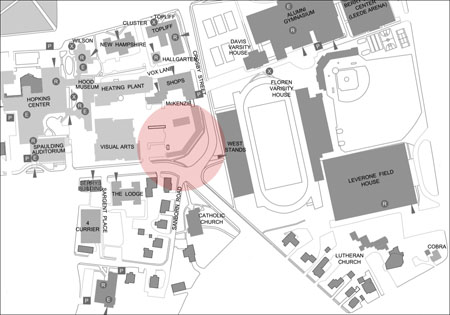
This is a large and important site. Whatever building goes here — let’s assume it is an arts-related building — will be visible to visitors arriving on Lebanon Street. It will need to be a gateway building, as the 2000 downtown Hanover plan illustrates so thoroughly. The Rogers Marvel 2002 Arts Center Analysis (pdf) also emphasizes the potential of this site on page 38.
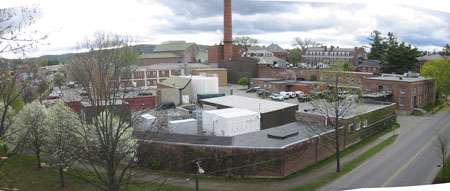
The first impulse is to follow the footprint of the existing low-scale facilities building. But this site is not only large, it is also unusually malleable. The college and town might be able to relocate Crosby Street in radical ways to completely reshape the ground available for the gateway building.
Why might Crosby be changeable? Because it has been changed in the past. Crosby Street was first laid out in 1872, to separate the state farm on the east from the state college dormitory site and other buildings on the west.
Crosby Street originally ran straight through to Lebanon Street. It was not until the early 1960s that Crosby’s southern delta was given its current incongruously suburban form. When Dartmouth sought permission to close down South College Street for the Hopkins Center, the Town asked Dartmouth to rework Crosby Street in return, aligning the street with Sanborn Road to form an ex post facto four-way intersection.
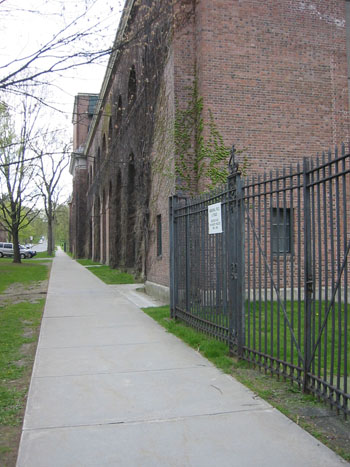
Should we worry about Sanborn Road if Crosby is realigned? No. In fact, the downtown Hanover plan proposes in text and an illustration that Sanborn Road be blocked off. Instead, Hovey Lane will give access to this neighborhood through a short outlet punched through to South Street (see map below).
Would the abandonment of Crosby Street’s current alignment open up any possibilities for a college building on the corner? Each of the following proposals assumes that McKenzie Hall/Shops on Crosby is preserved; Sanborn Road is rerouted; and commercial buildings are built on the college land along the south side of Lebanon Street.
II. The Maximum Arts
The gateway building could expand to fill all of the empty land added to the corner:
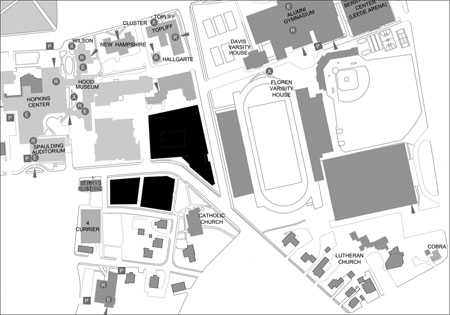
This plan would block an important view of Memorial Field and make Crosby Street into a narrow tunnel. A good use of space, but not good preservation or townscape.
Some variation on this plan, however, might be a good one:
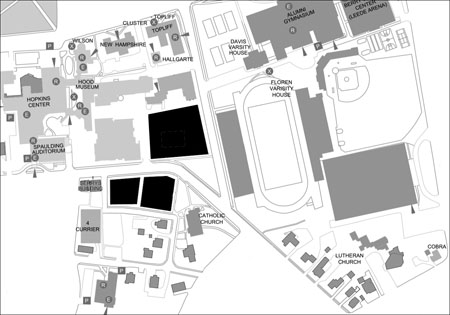
III. The Minimum Arts
Crosby could be pulled to the west, adding a big empty lawn in front of Memorial Field:
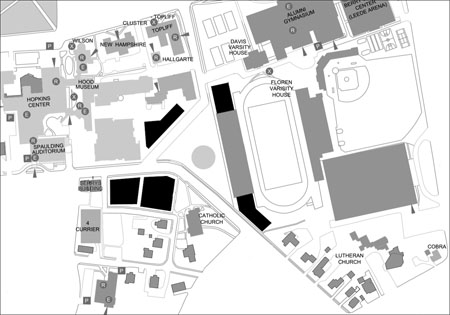
This plan would not make efficient use of space, and its creation of new lawns would not actually improve the view of Memorial Field.
IV. The Square and Temple
A big public square could be carved out of the surrounding buildings:
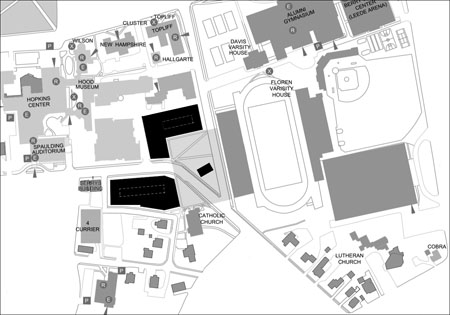
If the big square feels barren, a little temple that shares an alignment with nothing else could be dropped down in front of Memorial Field.
This plan would take advantage of the interesting fact that both Memorial Field and St. Denis Roman Catholic Church were designed in the early 1920s by Jens F. Larson. The two buildings appear to be perpendicular to each other, both aligned with Crosby Street.
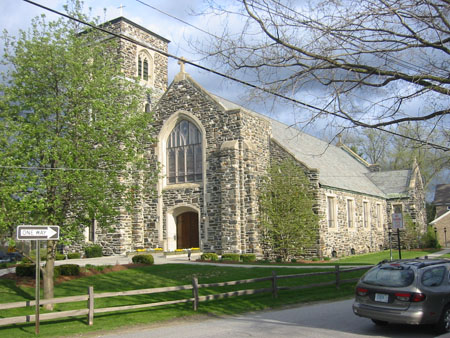
—–
[Update 11.17.2012: Broken link to Memorial Field image fixed.]
Ideas for a new heating plant
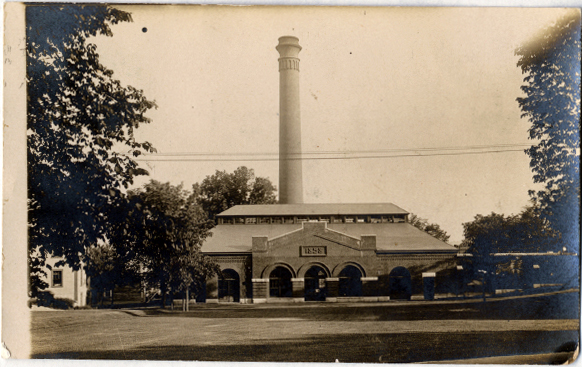
Dartmouth Heating Plant
The trend these days seems to be for colleges to drop coal (and probably oil, which is what powers Dartmouth’s plant) and go with natural gas, as at Cornell, or biomass, as at Middlebury.
From a planning standpoint alone, a new heating plant would be beneficial for Dartmouth. It would allow the Studio Art department to colonize the well-worn but supremely adaptable old heating plant. Assuming that a steam plant works as well at one end of the line as the other, Dartmouth could build an up-to-date replacement in what might be called the development zone north of the Life Sciences Center, an area that arguably should be developed densely and like a town, not like a campus.
Dartmouth is pragmatic enough that it might do a new heating plant as a metal shed. But because this is a gateway to campus, and for art’s sake, Dartmouth should have an interesting architect do it. No need to cite the great power plants through history, just look at this chiller plant at Chicago:
This is not to say that Hanover needs a building that looks like one by Murphy/Jahn, only that the utilitarian parts of campus could stand to be invested with some artistry.